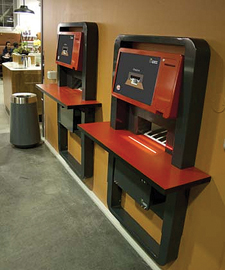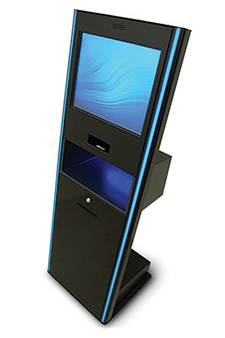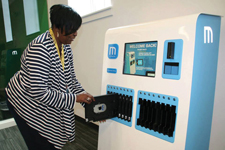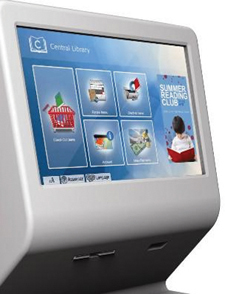Self-Check Solutions | Product Spotlight
Few things can be more frustrating to library patrons—or staff, for that matter—than a self-check system that’s ill-suited for its setting. But when such a system runs smoothly, it increases efficiency, protects materials, promotes library programming, and instills confidence in patrons, which translates into increased circulation and a staff with more time to focus on things like programs and services.
Most systems use barcode, radio frequency identification (RFID), electromagnetic (EM) strips, or a combination of these technologies. EM strips have one primary purpose: guarding against theft. Barcodes store information but must be scanned individually to reveal it. RFID, like barcode technology, stores information about the material—title, location, status, even reviews and read-alikes—but unlike barcodes, they don’t need line-of-sight to work. Multiple items, including CDs or DVDs inside cases, can be checked out simultaneously. They can also incorporate theft-protection that’s deactivated and activated when patrons check out or in. Most systems come standard with barcode technology and offer options for RFID.
Products: OneStop, X1, Media Case Controller
Company: Envisionware
Envisionware’s out-of-the-box self-check OneStop systems perform all the standard tasks you’d expect—checking in and out barcoded materials, renewing items not present, and displaying hold item details. Additional options include RFID software, an eCommerce suite to pay fines and fees, and its Media Case Controller (EMC2) that checks out and unlocks materials in one step. But Envisionware’s real strength is in its customization—appearance, interface, workflow, or all three—allowing libraries to make their systems look and operate the way they want them to. Software can even tie into other data sources, like widgets and plugins, to promote library services and programs, making the most of the self-check’s interactions with patrons.
strength is in its customization—appearance, interface, workflow, or all three—allowing libraries to make their systems look and operate the way they want them to. Software can even tie into other data sources, like widgets and plugins, to promote library services and programs, making the most of the self-check’s interactions with patrons.
“When we started in 2006, the vision was to create virtually unlimited variations in the software,” says CEO and founder Mike Monk. “So, if you look at our software in a dozen different libraries, each one would look so unique, you’d likely have no idea it was Envisionware.”
Hardware choices are flexible, too. Envisionware’s software can be installed on computers that are owned or contracted by the library for a lower-cost option, or arrive as self-contained desktop packages, complete with a touch screen computer, and preloaded, preconfigured, and custom-designed to fit each library’s decor and space needs.
In mid-March 2014, Envisionware announced its highly customizable X1 Series, available in desktop or kiosk model, barcode and/or RFID. Monk says the X1 was inspired by libraries requesting a system based on the build-your-own stuffed companion concept, allowing libraries to choose components, custom color combinations, and customization of the software itself, the latter at no additional cost using a guide included with the data sheet.
Products: LibraryMate
Company: Lyngsoe Library Systems
Lyngsoe Library Systems offers the LibraryMate series of self-service stations including the ergonomically designed LibraryMate 3200 and the multipurpose, wall-mountable LibraryMate 5000. Both systems include integrated RFID equipment, receipt printers, and customizable touch screen interfaces with easy-to- understand animations designed to make check-ins, check-outs, and renewals an intuitive process for patrons. In addition, both models can connect to a library’s ILS via Ethernet or optional Wi-Fi.
understand animations designed to make check-ins, check-outs, and renewals an intuitive process for patrons. In addition, both models can connect to a library’s ILS via Ethernet or optional Wi-Fi.
The LibraryMate 3200 kiosk includes an electrically adjustable countertop, enabling libraries to position the station for use by children, adults, or wheelchair users. These units can be paired with a Lyngsoe Reservation Garage, a stand-alone RFID and barcode reader–equipped book drop. When paired with the LibraryMate 3200, the Reservation Garage can facilitate presorting of materials by instructing users to drop specific items into the garage.
The LibraryMate 5000 can be used as a floor model or mounted on a wall and includes a large touch screen interface with a height-adjustable countertop, as well as a built-in, optional web surveillance function.
Products: smartserve
Company: Bibliotheca
Bibliotheca’s sleek line of smartserve systems operate using the firm’s simple, easy-to-use liber8 software and provide a full range of borrow, return, and account functions. Additional options include fines and fees payment, a barcode reader, and a materials unlocker. The smartserve 1000, just now rolling out in the United  States, takes the foundation of the smartserve 400 and powers it up. The smartserve 1000 accepts and dispenses both bills and coins, eliminating the need for repeated emptying and replenishing. It also accepts cards, Chip and PIN, and Near Field Communication (NFC), which means patrons can pay fines and fees using their virtual wallet simply by tapping their smartphone near the system. The smartserve 1000 is also the only one on the market with an aperture, or cavity, below the screen that defines the RFID read-zone, allowing multiple materials to be stacked, desensitized, and checked out in seconds.
States, takes the foundation of the smartserve 400 and powers it up. The smartserve 1000 accepts and dispenses both bills and coins, eliminating the need for repeated emptying and replenishing. It also accepts cards, Chip and PIN, and Near Field Communication (NFC), which means patrons can pay fines and fees using their virtual wallet simply by tapping their smartphone near the system. The smartserve 1000 is also the only one on the market with an aperture, or cavity, below the screen that defines the RFID read-zone, allowing multiple materials to be stacked, desensitized, and checked out in seconds.
According to Bryan Pasteryk, the company’s VP of sales for the Western region, that means materials are successfully checked out and desensitized almost 100 percent of the time. Bibliotheca also decided to make more efficient use of the real estate on smartserve 1000’s 22-inch touch screens by mounting them horizontally. “Because in libraries,” Pasteryk says, “we use a lot of lists, and scrolling on a touch screen isn’t easy, so this gives about 70 percent more room to list items.” The whole thing is tied together by guiding patrons through the process using a series of LEDs. When a patron is checking out, the light in the aperture turns on. Paying a fine by cash or credit card? The appropriate slot glows. Locked case? A light directs attention to the unlocker. Colors can even be customized to match the library’s theme or brand.
Products: CircIT, Media Passport, MediaSurfer
Company: Tech Logic
Tech Logic’s feature-rich CircIT self-check software is designed for customization—the patron-friendly interface is easily modified, and stations can be configured to work with RFID tags and/or barcodes. And, on the back end, the software includes customizable reporting tools. CircIT does not require proprietary  hardware, but Tech Logic does offer a line of CircIT Combo Stations with dual patron-facing and staff-facing touch screen monitors. The design enables staff to assist patrons without leaving the circulation desk.
hardware, but Tech Logic does offer a line of CircIT Combo Stations with dual patron-facing and staff-facing touch screen monitors. The design enables staff to assist patrons without leaving the circulation desk.
Tech Logic also offers self-check security solutions for high-value electronic devices and media. The Media Passport Secure Media Check-out solution lets libraries lock CDs and DVDs in Kwik-Case and Clear-Vu One-Time magnetic, keyless security cases integrated with the CircIT patron interface. Check-out transactions activate the Media Passport to unlock the security cases, logging the transaction and enabling patrons to remove their selected item. Similarly, Tech Logic recently launched MediaSurfer, a self-check kiosk system that allows patrons to check out and return tablets for in-library use.
Products: SelfCheck QuickConnect
Company: 3M
Matthew Bellamy, global product manager for 3M, points out that the self-check is likely the last thing patrons will interact with during their visit, a transaction typically lasting about 30 seconds. Bellamy says it’s the perfect chance to leave a lasting impression. That’s the goal for the 3M SelfCheck QuickConnect interface, which incorporates the power of NoveList to give customers recommendations on-screen based on their current checkouts. Patrons can place a title hold and print or email recommendations to themselves, essentially planning their next visit. The receipt, which often serves as a bookmark, can be appended to print personalized reading recommendations. The interface also gives libraries the ability to promote events, activities, and services through QuickConnect’s Patron Promos feature. For ease of check-out, QuickConnect works with simple animations and icons to guide users through the process. On the back end, QuickConnect offers a completely redesigned system manager with flexible tools, dozens of configurable design templates and themes, and easy access to reports and information, optimized for tablets so library staff can log in from a variety of devices.
the perfect chance to leave a lasting impression. That’s the goal for the 3M SelfCheck QuickConnect interface, which incorporates the power of NoveList to give customers recommendations on-screen based on their current checkouts. Patrons can place a title hold and print or email recommendations to themselves, essentially planning their next visit. The receipt, which often serves as a bookmark, can be appended to print personalized reading recommendations. The interface also gives libraries the ability to promote events, activities, and services through QuickConnect’s Patron Promos feature. For ease of check-out, QuickConnect works with simple animations and icons to guide users through the process. On the back end, QuickConnect offers a completely redesigned system manager with flexible tools, dozens of configurable design templates and themes, and easy access to reports and information, optimized for tablets so library staff can log in from a variety of devices.
RELATED
ALREADY A SUBSCRIBER? LOG IN
We are currently offering this content for free. Sign up now to activate your personal profile, where you can save articles for future viewing









Add Comment :-
Comment Policy:
Comment should not be empty !!!